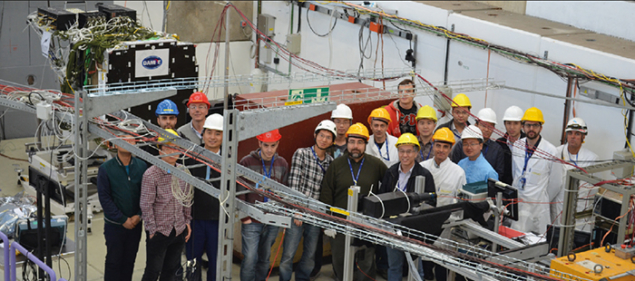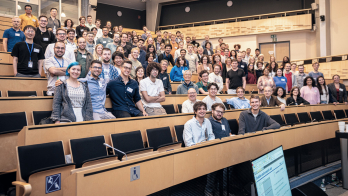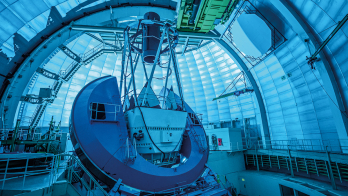
Image credit: DAMPE Collaboration.
On 17 December, the Chinese Academy of Sciences (CAS) successfully launched the DArk Matter Particle Explorer (DAMPE) satellite from the Jiuquan Satellite Launch Center in northwest China, marking the entrance of a new player in the global hunt for dark matter.
The nature of dark matter is one of the most fundamental questions of modern science, and many experiments have been set up to unravel this mystery, using either large underground detectors or at colliders (for example at the LHC), or with space missions (for example, AMS, CERN Courier November 2014 p6, or CALET, CERN Courier November 2015 p11).
DAMPE is the first science satellite launched by CAS. Built with advanced particle-detection technologies, DAMPE will extend the dark-matter search in space into the multi-TeV region. It will measure electrons and photons in the 5 GeV–10 TeV range with unprecedented energy resolution (1.5% at 100 GeV), to find dark-matter annihilation in these channels. It will also measure precisely the flux of nuclei up to above 100 TeV, which will bring new insights into the origin and propagation of high-energy cosmic rays. With its excellent photon-detection capability, the DAMPE mission is also well placed for new discoveries in high-energy γ-ray astronomy. The DAMPE collaboration consists of Chinese (Purple Mountain Observatory, University of Science and Technology, Institute of High Energy Physics, Institute of Modern Physics, Lanzhou, National Space Science Center) and European (University of Geneva, INFN Perugia, Bari and Lecce) institutes.
The DAMPE detector weighs 1.4 tonnes and consumes 400 W. It consists of, from top to bottom, a plastic scintillator detector (PSD) that serves as an anti-coincidence detector, a silicon-tungsten tracker-converter (STK), a BGO imaging calorimeter of about 31 radiation lengths, and a neutron detector (NUD). The STK, which improves the tracking and photon detection capability of DAMPE greatly, was proposed and designed by the European team and was constructed in Europe, in collaboration with IHEP, in a record time of two years. DAMPE became a CERN-recognised experiment in March 2014 and has profited greatly from the CERN test-beam facilities, both in the Proton Synchrotron and the Super Proton Synchrotron. In fact, CERN provided more than 60 days of beam from July 2012 to December 2015, allowing DAMPE to calibrate its detector extensively with various types of particles, with energy raging from 1 to 400 GeV.
Three days after the launch, on 20 December, the STK was powered on, and four days later, the high voltage of the calorimeter was also turned on. To the satisfaction of the collaboration, all of the detector sub-systems functioned very well, and in-orbit commissioning is now well under way to tune the detector to optimal condition for the three-year observation period. A great deal of data collection, process and analysis lie ahead, but thanks to CERN, we can look forward to a well-callibrated DAMPE detector to produce exciting new measurements in the very near future.








